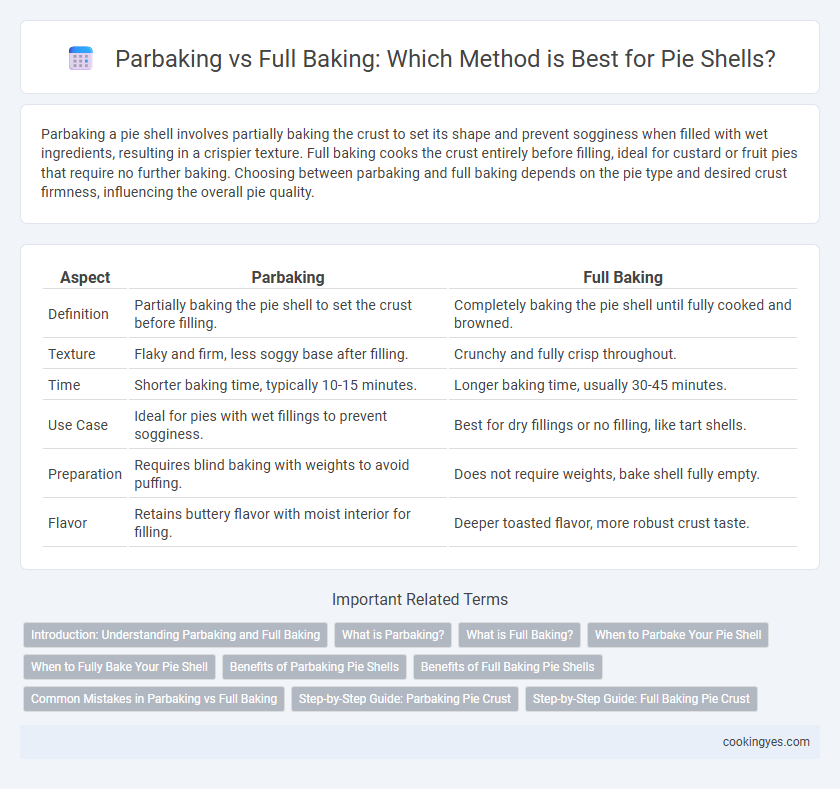Parbaking a pie shell involves partially baking the crust to set its shape and prevent sogginess when filled with wet ingredients, resulting in a crispier texture. Full baking cooks the crust entirely before filling, ideal for custard or fruit pies that require no further baking. Choosing between parbaking and full baking depends on the pie type and desired crust firmness, influencing the overall pie quality.
Table of Comparison
| Aspect | Parbaking | Full Baking |
|---|---|---|
| Definition | Partially baking the pie shell to set the crust before filling. | Completely baking the pie shell until fully cooked and browned. |
| Texture | Flaky and firm, less soggy base after filling. | Crunchy and fully crisp throughout. |
| Time | Shorter baking time, typically 10-15 minutes. | Longer baking time, usually 30-45 minutes. |
| Use Case | Ideal for pies with wet fillings to prevent sogginess. | Best for dry fillings or no filling, like tart shells. |
| Preparation | Requires blind baking with weights to avoid puffing. | Does not require weights, bake shell fully empty. |
| Flavor | Retains buttery flavor with moist interior for filling. | Deeper toasted flavor, more robust crust taste. |
Introduction: Understanding Parbaking and Full Baking
Parbaking involves partially baking the pie shell to set its structure before adding fillings, preventing sogginess and ensuring a crisp crust. Full baking fully cooks the pie shell, producing a golden, firm base ideal for dry fillings or standalone crust use. Choosing between parbaking and full baking depends on the specific pie recipe and desired texture.
What is Parbaking?
Parbaking is the process of partially baking a pie shell before adding the filling to ensure a crisp, fully cooked crust that prevents sogginess. This technique involves baking the crust at a high temperature until it is set but not fully browned, allowing it to finish baking with the filling. Parbaked pie shells are essential for custard or cream pies where the filling requires less baking time.
What is Full Baking?
Full baking, also known as blind baking, involves cooking the pie shell completely before adding any filling, ensuring a crisp and fully cooked crust. This method prevents sogginess in pies with wet fillings like custard or fruit, maintaining a firm texture and golden color. Full baking requires lining the crust with parchment paper and weights to avoid puffing or shrinking during the baking process.
When to Parbake Your Pie Shell
Parbaking a pie shell is essential when using wet or custard fillings that require shorter baking times, preventing a soggy bottom crust. This technique partially cooks the crust, creating a crisp barrier that maintains texture and structural integrity during the final baking phase. Ideal for recipes like cream pies or fruit tarts, parbaking ensures uniform doneness and a perfectly flaky crust.
When to Fully Bake Your Pie Shell
Fully bake your pie shell when preparing custard, cream, or fruit pies with moist fillings that require a sturdy, crisp base to prevent sogginess. Parbaking is ideal for pies with fillings that cook quickly or do not need thorough baking, but a fully baked shell is essential for pies needing structural integrity and a golden, evenly cooked crust. Baking the shell at 375degF to 400degF until golden brown ensures optimal texture and flavor for delicate fillings.
Benefits of Parbaking Pie Shells
Parbaking pie shells partially cooks the crust, creating a sturdy barrier that prevents sogginess from wet fillings. This technique ensures even baking, resulting in a flaky, crisp texture while reducing overall baking time when the filling is added later. Parbaked shells maintain structural integrity, making them ideal for custard or cream pies that require no further baking.
Benefits of Full Baking Pie Shells
Full baking pie shells ensures a crisp, golden crust that maintains its structure and prevents sogginess when filled with moist ingredients. The high heat fully cooks the dough, enhancing flavor complexity through caramelization and Maillard reactions. This method also offers better texture contrast between the shell and filling, resulting in a more satisfying pie experience.
Common Mistakes in Parbaking vs Full Baking
Parbaking pie shells often leads to common mistakes such as underbaking, resulting in a soggy bottom or overbrowning if timing is misjudged. Full baking errors typically involve overcooking, which can cause a dry, brittle crust that difficult to slice. Understanding precise temperature control and baking duration for both methods ensures optimal texture and prevents these frequent pitfalls in pie shell preparation.
Step-by-Step Guide: Parbaking Pie Crust
Parbaking a pie crust involves partially baking the shell to set the dough and prevent sogginess when adding wet fillings, typically at 375degF (190degC) for 15-20 minutes. Begin by rolling out the dough, transferring it to the pie dish, and docking the surface with a fork to avoid air bubbles. Place parchment paper and pie weights on top before baking, then remove weights and bake for an additional 5 minutes to crisp the bottom without fully browning the crust.
Step-by-Step Guide: Full Baking Pie Crust
Full baking a pie crust requires preheating the oven to 375degF (190degC) and placing the prepared crust in the oven for 20-25 minutes until golden brown. Use pie weights or dried beans to prevent bubbling during the initial 15 minutes, then remove weights to allow the crust edges to crisp. This method ensures a fully cooked, sturdy base ideal for wet or delicate fillings that require no further baking.
Parbaking vs Full Baking for Pie Shell Infographic

 cookingyes.com
cookingyes.com